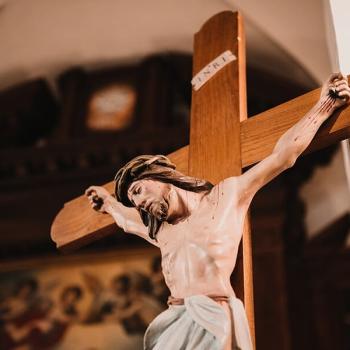 Editor’s Note: This is the first in a weekly Lenten series on the body and blood of Christ by Church History Professor Kelly Pigott.
Editor’s Note: This is the first in a weekly Lenten series on the body and blood of Christ by Church History Professor Kelly Pigott.
Unless one is referring to the Old Testament sacrificial system, or a place where wedding vows are made, it seems the word “altar” has fallen out of favor with many Protestants. Perhaps the reason dates back to the Reformation when a huge dispute arose over the doctrine known as the “Sacrifice of the Mass.” Essentially, in this, the Eucharist (or the bread of the Lord’s Supper) is understood to be an additional sacrifice so that it has the power to atone for sins. In other words, every time a mass is said, Jesus is sacrificed all over again (though technically, Aquinas argued that the mass was an image of the real sacrifice of Christ).
Either way, Protestants rejected this idea, claiming that Jesus’ sacrifice on the cross was a “once-for-all” sacrifice that covered every sin. Ever. Period. And no additional sacrifices were needed. The idea that Jesus was sacrificed again at each mass in the Eucharist actually offended them. And the Protestants became quite grumpy about it. The Catholics responded to Protestant grumpiness by calling the Council of Trent. In 1562 it published no less than nine canons affirming the Sacrifice of the Mass, declaring that it not only atoned for the sins of the living, but the dead as well (at least those in Purgatory, another doctrine Protestants tended to get grumpy about). Suffice it to say, that it was a long time before Protestants and Catholics were able to speak civilly about this matter to one another.
Since the priest consecrated the Eucharist while holding the host over the altar, Protestants connected the two ideas together and assumed that the reason it was called an altar was because of the doctrine of the Sacrifice of the Mass. So ever since then, most have preferred to refer to it as a “table.” But long before the doctrine of the Sacrifice of the Mass originated, early Christians referred to the table as an altar. One of the earliest references comes from a letter written by Ignatius, a first century bishop of Antioch. Other Church Fathers also regularly referred to it as such, and they even spoke of the Eucharist as a “sacrifice.” Now, they don’t really go into detail about this, for they were satisfied in understanding the Eucharist or the Sacrifice as a great mystery, designed to illicit awe and gratitude in the worshiper over the willingness of Jesus to die for them. But suffice it to say that words such as “sacrifice” and “altar” were important in their understanding of what happened during communion from the very beginning.
“Table” is a good word, too. And in fact, both “altar” and “table” were used interchangeably. All of this is to say that there were many layers of meaning to this most ancient place where Jesus originally met with his disciples for a meal, and then declared that the bread was his body, and the wine was his blood, commanding his followers to consume them in remembrance of him. As an altar, the elements become the body and blood of Christ, and the worshiper is vividly reminded of the ultimate sacrifice Jesus made out of his deep love for us. As a table, the elements are bread and wine offering the worshiper spiritual food, to be consumed in community with his or her brothers and sisters in Christ. It is in this context that the word “Eucharist” or literally “to give thanks” makes the most sense, because it is at this table that God is providing for our deepest needs physically, spiritually, and emotionally, for which we are giving thanks.
Ironically, however, the story of the table or altar has a lot of drama and tragedy, even though today, many have forgotten these family feuds as the table has become more of an enigma. As postmodern Christians ponder the table, they view it more like an odd antique one would find in a grandparent’s house. It looks pretty, but it doesn’t seem to have any practical purpose anymore. Even in traditions where communion is still the apex of worship, not many members are aware of the place of prominence the altar has traditionally held.
Not only has the table been the center of attention in worship, but it has also been at the center of some of the Church’s fiercest fights. Roman Emperors were cowed here. The Latin and Eastern churches got a divorce here. The Protestant church became Protestant churches here. Catholics and Protestant slaughtered each other here. And one famous founder of a major denomination dissed his ex-girlfriend here. Perhaps all this drama is one reason why many contemporary churches have decided to tuck this odd piece of furniture in the attic.
It’s hard to blame them. And yet, maybe we are missing something vital and ancient to our faith by doing so. For as the early Christians gathered at the altar to break bread, they deemed it so important that they were willing to risk their lives and the lives of their families in order to take, eat, and drink.
Leading up to Easter, I’d like to tell you the story of the table, from its humble beginning with Jesus and the disciples, to the battlefield it became as powerful figures fought over the body and blood of Christ. I hope you’ll join me.
Photo credit: wideonet/Shutterstock.som













